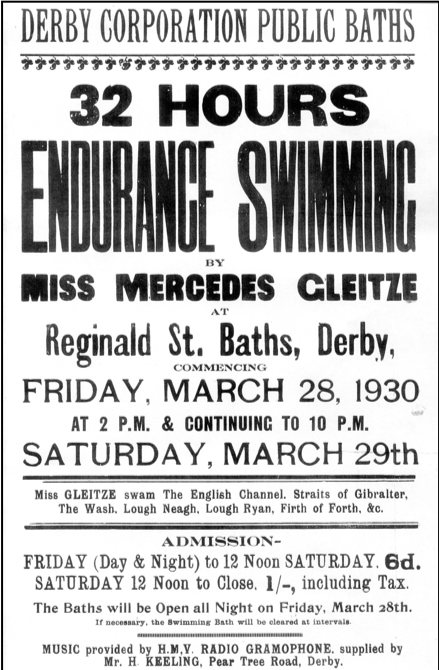Derby (32 hours) – 28 to 29 March 1930
Reginald Street Baths
Derby was Mercedes’s next destination. She had previous visited that city in February to outline proposals to Corporation officials for a further attempt on her own endurance record in one of their baths, to which she had received a favourable response.
On 19 March, she caught the train from St Pancras and was met at Derby Station by Cllr. W.H. Moult, Vice-Chairman of the Parks and Baths Committee, and Mr J.J. Mainprize, Superintendent of the Reginald Street Baths who was overseeing the event. A Derby Daily Telegraph journalist was also present to interview her about the proposed swim, and in particular about her training programme.
Mercedes had asked Mr Mainprize to book her a room in a private house or boarding house at moderate terms, and she settled in at 118 Osmaston Road to prepare for the swim. The Reginald Street Baths measured 100 feet by 30 feet, and there was space for 300 spectators. It doubled up as a skating rink during the winter months, and during its conversion from a rink to a pool Mercedes trained in the smaller Full Street Baths.

The weather that week was good, so she was able to undertake a large amount of valuable land training outdoors. Arrangements had also been made for a local masseur to give her one hour’s massage each day for eight days until the start of the swim.
Enough independent volunteers had come forward to act as observers and timekeepers at the swim, including some from the Derby L.M.S. Ladies’ Swimming Club, Burton Ladies’ Swimming Club, and Ley’s Ladies’ Swimming Club. Additionally, several members of the Corporation Baths Committee performed official duties, Dr Kidman of Derby agreed to attend Mercedes before and after the swim, and Nurse Mossop of the Rolls-Royce Welfare Department stood by during the whole of the swim.
Caption reads:
Miss Mercedes Gleitze, the famous swimmer, being fed during her 32 hours endurance attempt at Reginald-street Baths, Derby. If she succeeds she will leave the water at 10 o’clock to-night.
Reproduced courtesy of the Derby Telegraph

The Derby Daily Telegraph reported on the swim, which started at 2.05 p.m. on Friday 28 March and finished at 10.05 p.m. on Saturday 29 March. Throughout the long night there were never less than 80 spectators, and during the hours of 7.00 a.m. to 8.00 a.m. workers looked in at the baths before going to their jobs.
Mercedes managed to conquer the lethargy, which appeared likely at one point to overcome her in the early hours of the morning. Her head sank into the water at periods, but her spirits were kept up by the almost continuous cheering and applause of the crowds on poolside. During one of her most trying times Alderman Raynes MP, who had paid two visits to see her, led the singing of the hymn Abide with Me in an effort to keep her awake. She experienced headache and nausea for a little while, but revived at dawn when the electric lights were extinguished. At a later interview she put this down to experimenting with solid food (half a beef sandwich), which caused indigestion. Throughout the swim, she averaged 32 strokes per minute.
Barry Bilson, the well-known Derby baritone, sang solos without accompaniment to entertain the crowds during the early morning, and later that day he visited again and gave solos on his concertina. The Mayoress of Derby, Mrs J.H.H. Grant, also attended during the evening to lend her support to the event. At different periods the spectators were cleared from the baths to allow others waiting in queues to enter.
The newspapers reported amazing scenes at the end of the swim. People were packed to suffocation inside the baths and they cheered hysterically as Mercedes completed her 32-hour swim. So great was the crush and so intense the excitement inside, that St John Ambulance men were kept working at top speed to deal with fainting spectators. During the last tense hour, hundreds of people gathered in Reginald Street and reinforcements of police were summoned to keep order.
After the finish of the swim Mercedes was taken to her lodgings in Osmaston Road in a Derby Borough Police ambulance. As usual she had to be carried on a stretcher, and her swimming costume had to be cut off as her skin was so tender to the touch but, following a medical examination, Dr Kidman reported to the waiting press that “she is wonderfully well after it.”
The Derby Telegraph’s swimming expert, writing under the pen name of ‘Crawl’, said in that paper’s edition on 31 March 1930:
The successful endurance swim of Miss Gleitze was one of the pluckiest things I have ever seen. The ordeal of swimming for 32 hours in luke-warm water is really beyond description. When I entered the water at the finish with Mr Brown and Mr Clark to help Miss Gleitze from the baths, I found her skin in a terrible condition. A remarkable thing is that she was so mentally efficient right to the finish. I interviewed Miss Gleitze at breakfast yesterday, and by that time she had fully recovered. Her hands and face were again normal and showed no effects of the long emersion.
Mercedes received a letter from the Mayor of Derby, Mr J.H.H. Grant, congratulating her on her successful swim and saying how delighted he was that the people of Derby welcomed her in such large numbers. Altogether about 7,000 people paid to witness the swim. He said he was sure that her visit and performance would give a decided impetus to swimming in this town.
A brooch with the Derby Coat of Arms was later sent to Mercedes by the Chairman and members of the Baths Committee as a memento of her swim. She was delighted with the gift and she sent a letter to the Chairman telling them it would rank as one of her most treasured possessions.